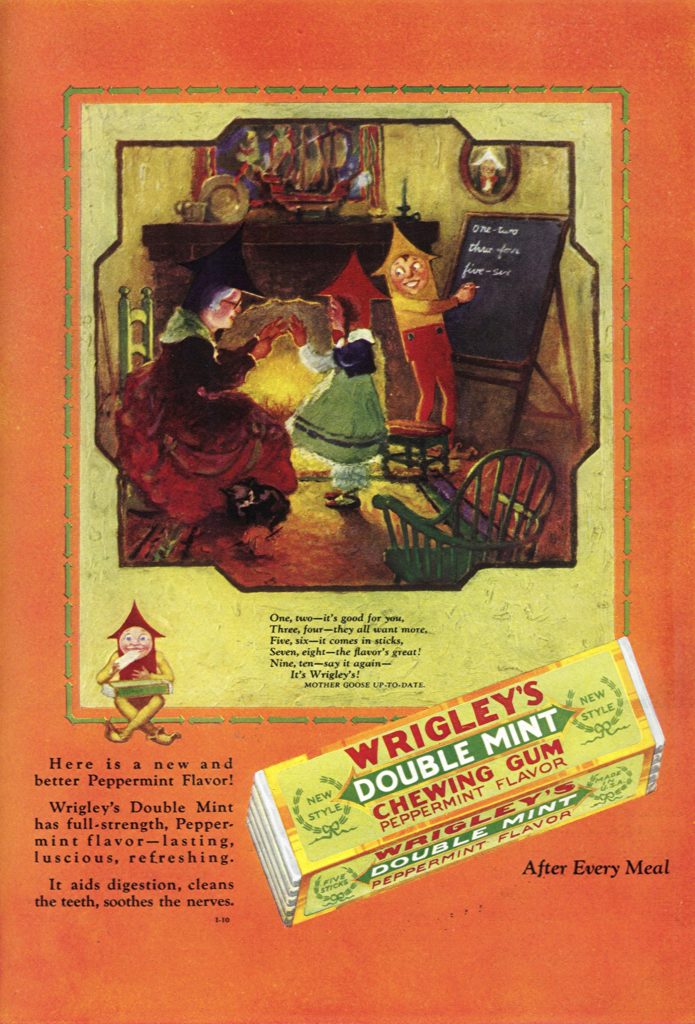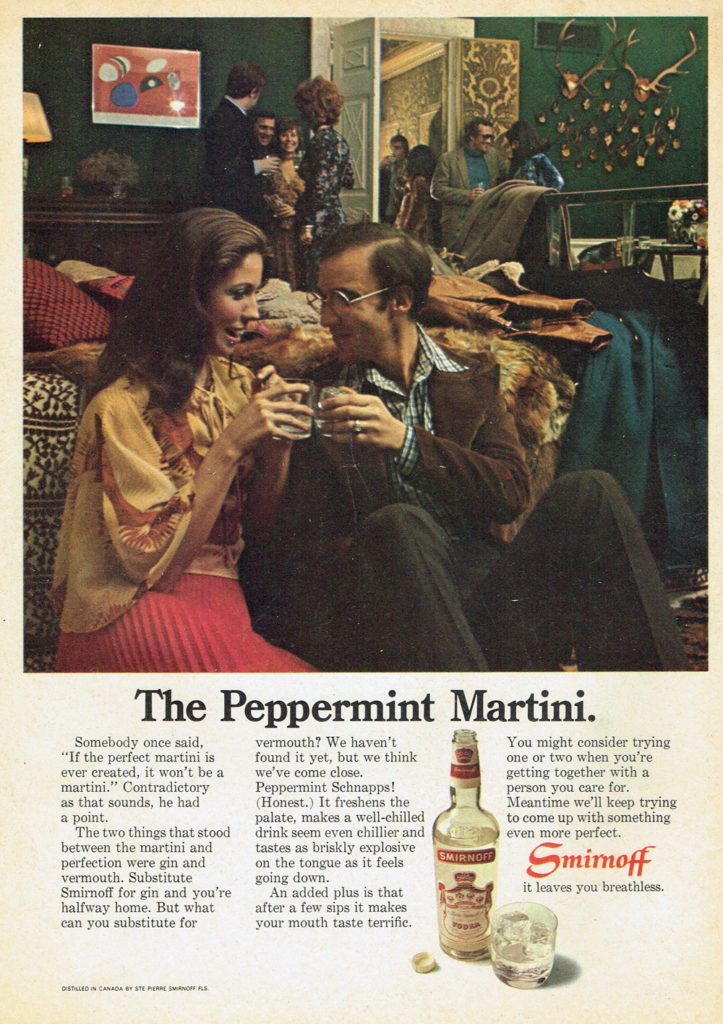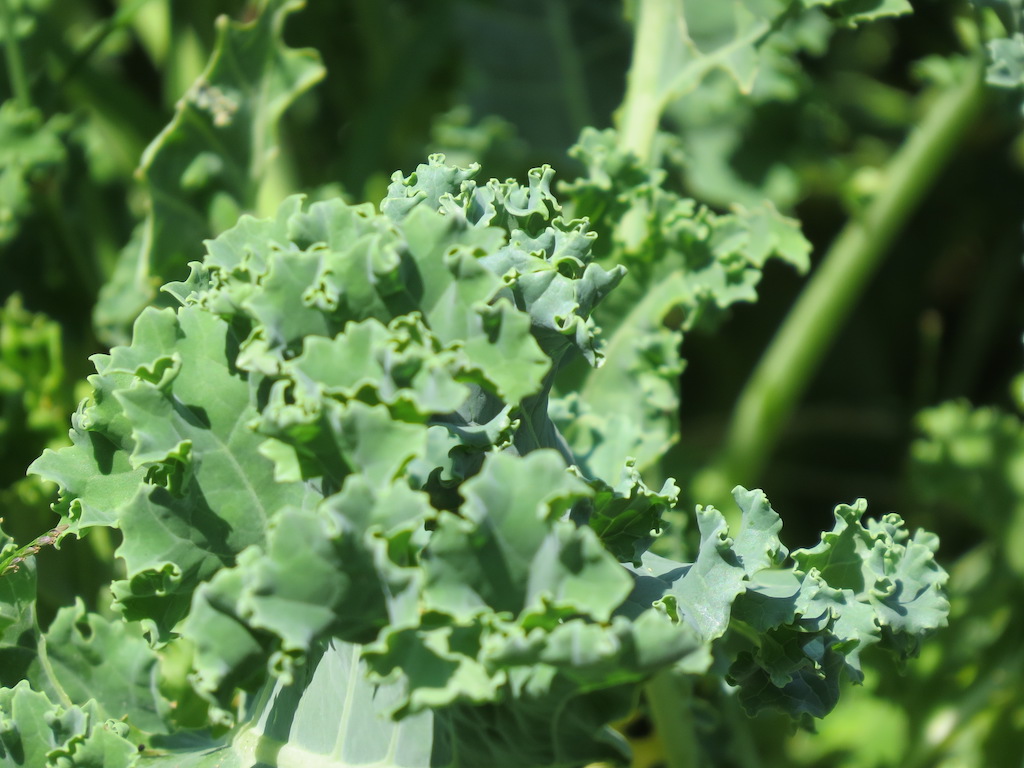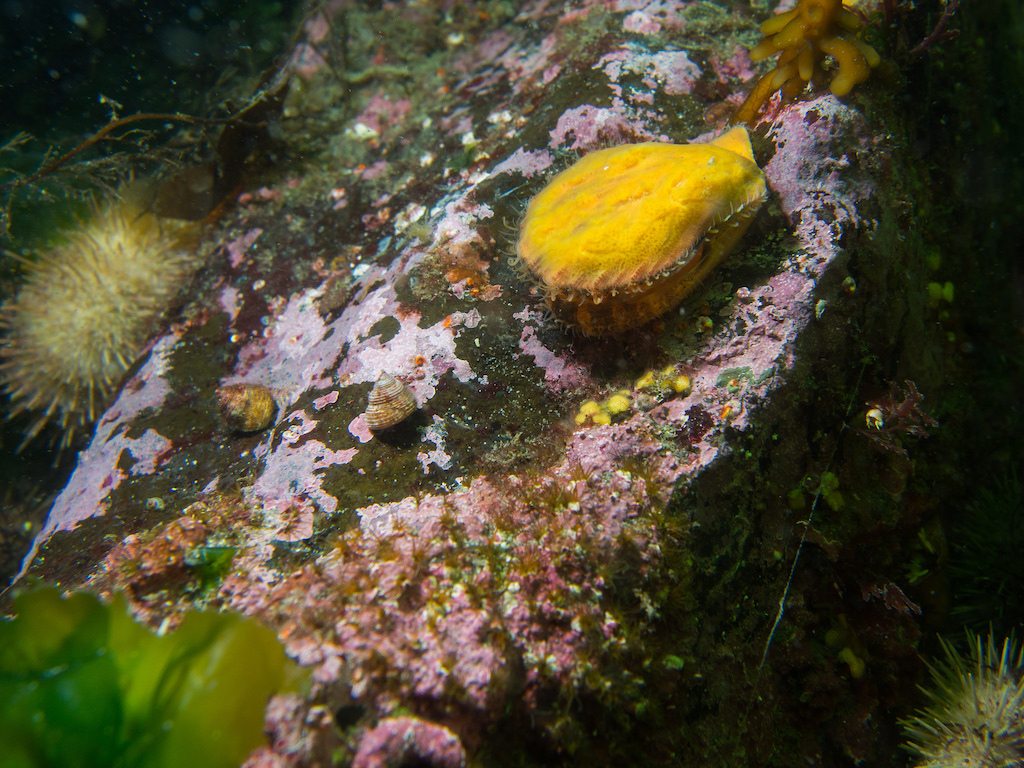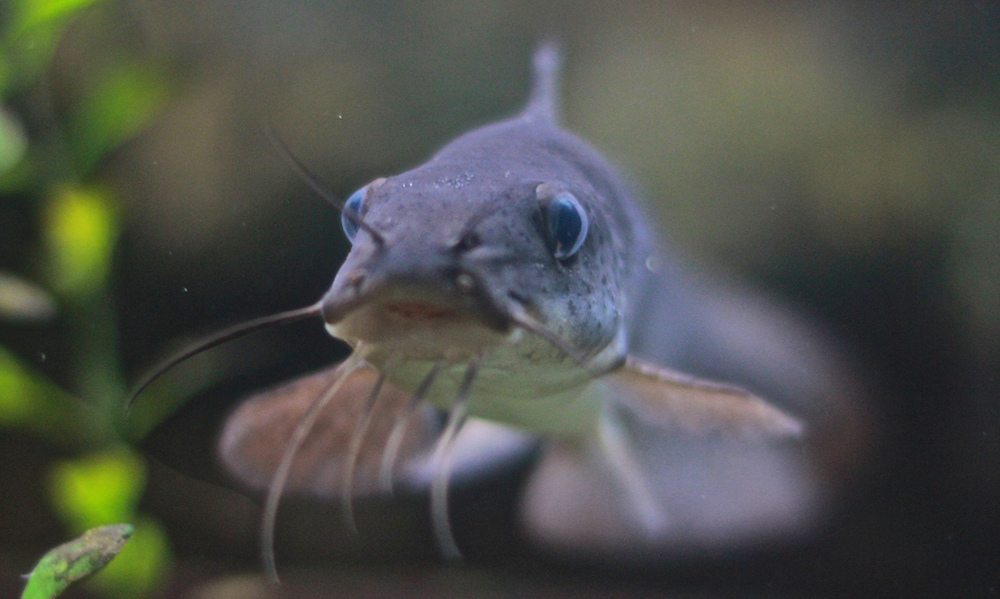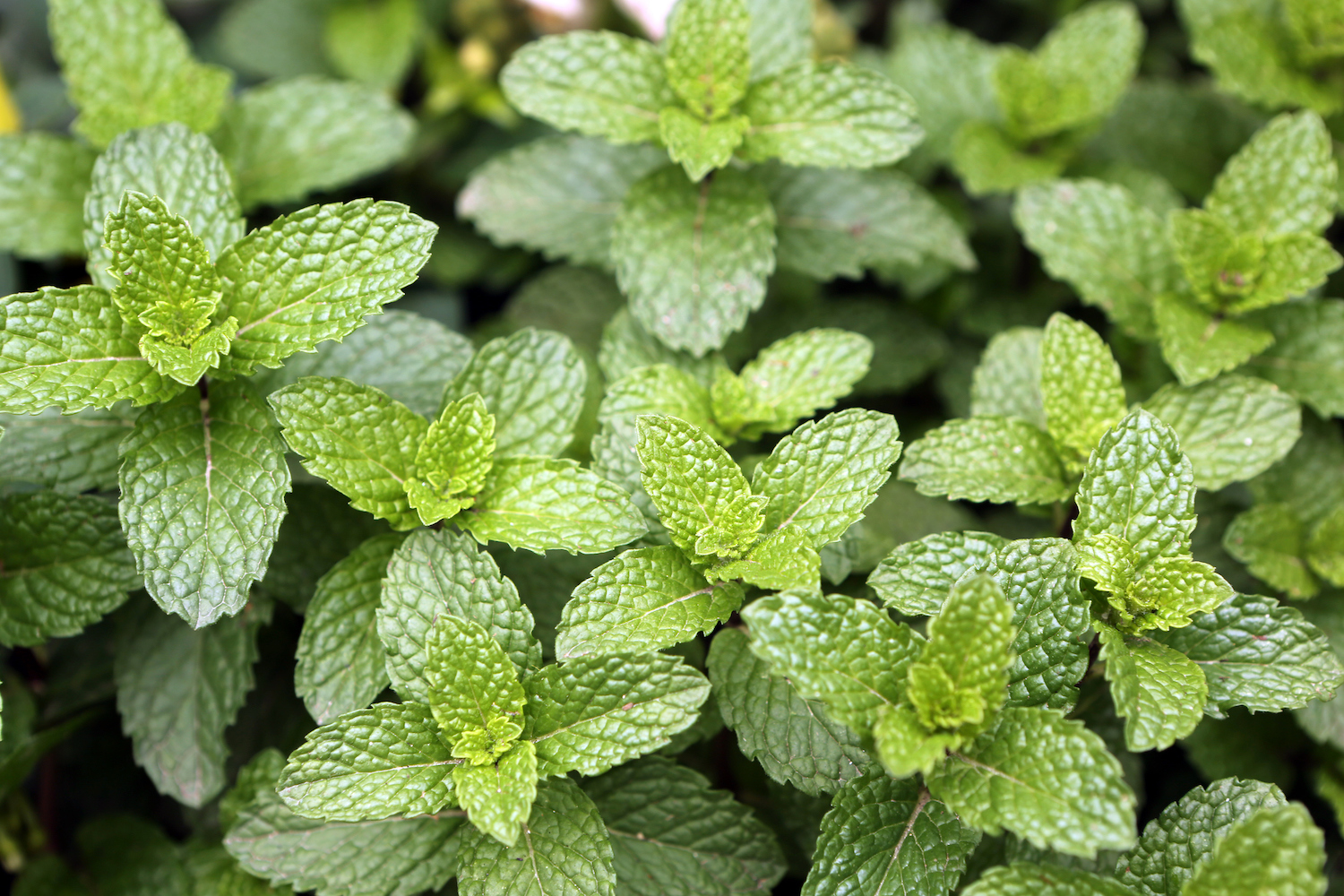
iStock/tc397
It’s hard to imagine a world without peppermint, especially at this time of year. But while we enjoy our candy canes, stakeholders are hard-pressed to find a solution to the incurable threat called Verticillium wilt.
Peppermint farming is in trouble, though you may not realize this if you’ve encountered the plant in your backyard or home garden. Where it’s unwanted, peppermint, like other mints, grows abundantly and easily crowds other plants out. On homesteading forums, people bemoan the insistent spread of “evil mint,” which can quickly overtake a lawn minding its own business. Novice gardening boards abound with warnings of how invasive it can become. To completely rid yourself of it, you have to dig and pull out every plant by its stubborn, sprawling roots.
When it comes to commercial farming, however, peppermint is under siege. The primary threat? An incurable and deadly fungal disease called Verticillium wilt, which infects plants by latching onto their roots and stems, gradually blocking the upward flow of nutrients and water. Farms are more vulnerable to the fungal wrath because it can attack a wide range of crops planted on fields. And once a field is infected, the disease can lay dormant for a decade and effectively render the ground impractical for mint farming in perpetuity.
Many major companies like chewing gum giant Wrigley are sourcing mint oil from major mint-producing regions in northern India
For crops, the fungus is fatal. For mint farmers, it foretells the major uprooting of a valuable industry. The spicy, clean herb plays an outsized role in our daily lives. Chances are, you do at least one of the following: Brush your teeth with peppermint-flavored toothpaste, use peppermint-scented body products, chew peppermint in gum, drink peppermint in beverages, or cook with peppermint in food. This current moment leading up to Christmas is a particularly potent reminder of its significance in common cultural practices. Depending on where you are, you can practically taste peppermint in the air as it diffuses from bark, patties, candy canes, and seasonal lattes.
It’s for those reasons, and more, that researchers are searching urgently for a solution to Verticillium wilt, that manufacturers of mint products are investing in mint farming abroad, and that agribusinesses are trying to perfect synthetic substitutes. Without peppermint, life would be—and smell, and taste—unrecognizable.
Civilizations have been distilling peppermint for oil as far back as 410 A.D., though the plant was reportedly first categorized as a species by English botanist John Ray in 1696. Long a popular ingredient in the pharmaceutical industry, domestic production emerged as a cost-effective alternative to British imports in the early 1800s. The first mint farms were established on the East Coast in the early 1800s, before shifting to the Great Lakes region in the 1900s, and then further to the Pacific Northwest in the 1940s, where production is now heavily concentrated in the Columbia River Basin. This movement was driven, in part, by the spread of Verticillium wilt. Unfortunately, some mint farmers incidentally brought the disease with them to their new homes. Once infected with wilt, fields suffer from lower crop yields that eventually render peppermint farming unprofitable.
“As Verticillium wilt disease became a problem, it wasn’t solved—the industry just migrated further west,” says Mark Lange, an associate professor of molecular plant science at Washington State University (WSU). “So then the Midwest became a growing area of prominence for mint. And then as Verticillium pressure became too high there, it moved further and now the states that grow the most mint are on the west coast—so Oregon, Washington, Idaho. But you can’t go further west.”
The wilt co-infects mint crops with an accomplice—tiny worms called nematodes that worsen the symptoms of attack.
Instead, in the past few decades, American farmers have focused on preventing Verticillium (no fungicide exists to eradicate it), which can lay dormant in soil for years on end. Often, the wilt co-infects mint crops with an accomplice—tiny worms called nematodes that worsen the symptoms of attack. There are, however, a number of precautionary measures that can reduce the risk and spread of the wilt. For one, farmers are encouraged to plant what is known as “nuclear” rootstock—plants that were first grown in sterile greenhouses and guaranteed to be free of wilt. Fumigation, the literal smoking of soil, is a costly, but somewhat effective way to reduce, but not eliminate, the presence of the fungus.
But once a field is infected, peppermint farmers don’t have many options besides planting other, wilt-resistant crops, or finding unminted land. Crossing peppermint with other mints that are wilt-resistant isn’t an option. That’s because peppermint is not its own species, but a unique combination of two other mints, watermint and spearmint. Like most other hybrid flora and fauna (see: mules), peppermint doesn’t produce viable seeds. (Though some unscrupulous internet retailers would like you to think otherwise: you can buy “peppermint seeds” on Amazon, Home Depot, Ebay, and elsewhere.) Rather, it can be grown only out of the rootstock of other peppermint plants. Let that sink in: All peppermint grown in the U.S. comes from the same parent plant. And because peppermint can’t reproduce, scientists can’t cross-breed it with other mints to develop new versions with advantageous traits, like wilt resistance.
“We just have to be careful,” explains Denise Colley, a mint farmer based in Othello, Washington. “When we go to lease a piece of ground from another farmer, we’ll ask what the history of that piece of ground is. You want to do what you can to prevent it from spreading into another field. If you know that [Verticillium wilt] has been in one field, and you’re moving equipment, you might make sure that your equipment is clean.”
These circumstances paint peppermint into a corner of sorts: running out of land to grow on, unable to adapt to a disease that threatens it. Some researchers have explored genetic modification as a way to dig the species out of its predicament. In the 1970s, scientists affiliated with mint company A.M. Todd exposed more than 100,000 peppermint plants to irradiation, a process that randomly scrambled their genetic makeup, and then planted them into a wilt-ridden field. Of the cultivars that survived, two were ultimately brought to market and planted commercially. While the irradiated peppermint cultivars were less susceptible to wilt, they also reportedly produced less than ideal oil yields, according to Lange. However, they did also point to the possibility of peppermint breeding.
TOGGLE BETWEEN THE THREE GRAPHS BELOW TO EXPLORE HOW PEPPERMINT PRODUCTION HAS CHANGED OVER TIME:
A more exact yet contentious option is modification through transgenesis, a form of genetic engineering in which precise genes from one organism are placed into the genetic material of another. In Lange’s past research, he’s found success in engineering peppermint varieties that produce significantly higher oil yields. However, the findings also faced some expected pushback from producers, and the efforts were abandoned.
“There was a lot of resistance within the industry, because with transgenic plants, you have issues with consumer acceptance,” he explains. Peppermint is far from the only crop whose cultivation could benefit from genetic modification in the race to thwart disease. Scientists have produced ringspot-resistant papayas and greening-resistant oranges, but have also faced social backlash from consumers and producers who are wary of GMOs.
With funding from the Mint Industry Research Council (MIRC), Lange and fellow mint researchers are now instead seeking a solution within a much more formidable challenge: recreating peppermint from ancestral species—or, in other words, from scratch. As I mentioned earlier, peppermint is a unique hybrid species, descended over time from the crossing of many other mint species, some of which were hybrids themselves. This genomic complexity is why peppermint can’t produce seeds. Triangulating just how the plant came to be created is kind of like trying to unscramble a massive genetic Rubik’s cube. Right now, there’s no timeline yet of when—or if—these efforts, which are still preliminary, will pay off.
Over time manufacturers of mint products have re-oriented themselves to supplement domestic peppermint oil use with alternatives farmed abroad.
In addition to peppermint, American farmers also cultivate to a lesser extent two other mints: native spearmint and Scotch spearmint. Native spearmint has a degree of wilt-resistance, and the fresh mint you buy at the supermarket’s produce section is likely spearmint. However, both spearmints have lower levels of menthol, the prized compound that gives peppermint its cooling quality and makes it such a precious herb. Menthol is the extract that industries use to flavor everything from toothpaste to cigarettes to tea.
The peppermint farmers I spoke with noted that there are other, non-fungal forces reshaping the market, too. One game changer is the development of synthetic menthol. In 1973, German agribusiness giant Symrise began manufacturing a form of “nature-identical” menthol. Production has ramped up in recent years to match rising demand for mint-flavored products. Because synthetic menthol is insulated from the volatility of farming, the company says that its price and supply is comparatively stable. Other ingredient manufacturers have also joined the fray.
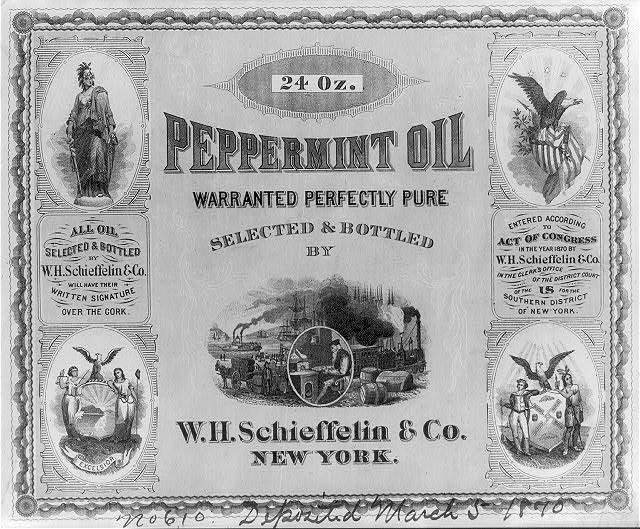
Library of Congress
A peppermint oil label from 1870
Imported oil is another factor in the peppermint equation. Over time manufacturers of mint products have re-oriented themselves to supplement domestic peppermint oil use with alternatives farmed abroad. Many companies, from chewing gum giant Wrigley to cult-favorite soap manufacturer Dr. Bronner, are sourcing mint oil from major mint-producing regions in northern India. The primary mint species produced in India is a high-menthol species called corn mint. It has twice the menthol content compared to peppermint, making it a productive resource for manufacturers. Menthol has the same properties whether it’s derived from corn mint or peppermint, though the former is less marketable than peppermint.
The cumulative effect of these pressures is evident in the numbers. In 1997, the American peppermint industry’s most productive year, farmers harvested 9.97 million pounds of oil across 135,600 acres, according to the Department of Agriculture. Last year saw the lowest yield in at least 25 years, with production clocking in at 5.38 million pounds across 58,500 acres, despite an uptick in yield per acre.
“Mint is valuable, it’s beautiful, but it’s not something people rely on for sustenance.”
The gradual loss of American peppermint is a quiet story—there’s no deadline, no global risk of species extinction. Perhaps most importantly, it poses little foreseeable threat to the everyday lives of consumers. Thanks to both imported and synthetic mint oils, may our chewing gum, our toothpaste, our breaths stay forever fresh. The change taking place in the mint industry resembles more the gradual replacement of Jenga blocks than the collapse of a tower.
Consider the comparable tale of the Cavendish banana, the ubiquitous fruit currently under threat of a wilting disease of its own: Fusarium wilt, or (as it’s popularly known) Panama disease. Already prevalent in Asia, most experts have concluded that it’s just a matter of time before the wilt, which is resistant to fungicides, reaches major banana-producing regions in Latin America. Compared to Verticillium wilt, Panama disease has been widely covered, and its solutions generously funded. That’s likely because bananas are major cash crop, a popular and beloved food, and the center of attention in many grocery stores. Mint, on the other hand, plays more of a supporting role when it comes to farming and feeding.
Menthol is the extract industries use to flavor everything from toothpaste to cigarettes to tea
“Mint is valuable, it’s beautiful, but it’s not something people rely on for sustenance,” says David Wheeler, an assistant professor of plant science at the University of Montana. “We would all survive, maybe be a little [more] smelly, but we would find something else to put in our mouths to freshen our breath.” The peppermint farmers I spoke with told that, without mint, they would likely switch over to farming other crops.
American mint farmers share a similar sense of weary resignation about Verticillium wilt. ““If [peppermint] were as big a crop as soy or corn, we’d have a solution to verticillium wilt by now,” says Max Nilsson, a second-generation peppermint farmer. In the best case scenario, researchers will find a way to breed a cost-effective, wilt-resistant alternative to peppermint. In the worst case scenario, well, there’s a growing world of minty alternatives to choose from.
For many of these farmers, the sense of loss is largely a sentimental pang for days gone by. Nilsson, who lives in La Grange, Oregon—a town which has a park named Candy Cane Park—notes that scents are powerful and evocative: “The smell has always been a part of my summer during childhood. It reminds me of Christmas in August.”
Still, Nilsson is a realist.
“[Scientists] will either figure something out and find resistance or some way to combat it—or they won’t,” says Nilsson. “And we’ll have to move on to whatever is next.”
